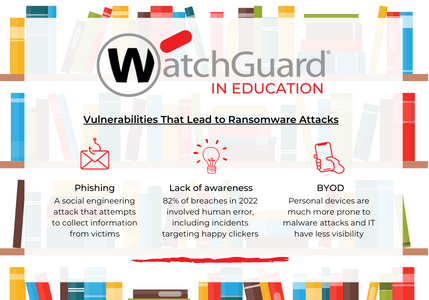09 Mar 2023 WatchGuard in Education
WatchGuard in Education
WHO ARE WATCHGUARD?
WatchGuard’s industry-leading network security completed Purdicom’s solution offering perfectly, complementing our vendors and being used within our own offices. WatchGuard provides the solution for small-medium businesses with enterprise-grade cyber security technology, protecting your online and offline world. Using intelligent protection, effectively protecting against todays and future evolving threats.
Top cybersecurity practices for the Education Sector
For the education sector, data security ranges from the need to protect devices and safeguard sensitive information to ensuring the privacy of its users, including students, parents, and staff. There is no other environment that requires more from its IT infrastructure than Education. For both performance and security, it is vital to ensure that the level of security offered, can protect user information, devices, and systems without being compromised.
Over the past few years, the education sector has evolved to ensure learning was not impacted even through the challenges they have faced. The modern-day classroom now involves a combination of remote learning and in-person teaching, as well as the use of personal devices.
Here are the most common cybersecurity threats affecting Education:
- Phishing: this is a deceptive practice where the attacker seeks to obtain sensitive data from the victim, such as usernames, passwords, credit card details, etc. There are many ways to carry out this scam, but the main entry vector is the use of emails or text messages that appear to come from trusted sources and contain malware attachments or links to fraudulent websites.
- BYOD (bring your own device): personal devices are much more prone to malware, as they access websites that do not necessarily offer the right level of security. Additionally, IT staff at educational centres have no visibility or assurance that malware has not been downloaded onto these devices.
- Doxing and cyberbullying: in this form of online harassment an individual’s private information is disseminated without their consent, allowing them to be identified and exposing their personal life and compromising their safety, to defame them or cause harm of some kind.
- Domain spoofing: a type of phishing attack in which hackers register web domains using names like those of legitimate websites to appear trustworthy and to deceive users through a scam.
- End-of-life software: this is the use of outdated software or computing devices that no longer receive the necessary patches, updates and maintenance making them more susceptible to vulnerabilities.
Rasomeware is a growing risk
Ransomware is the main cyber threat in the education sector. In recent years these attacks have increased significantly and as a result, the UK’s National Cyber Security Centre (NCSC) has had to issue numerous warnings about ransomware attacks after several were reported. In one instance, these threats forced a school to postpone its reopening. Did you know, that 78% of schools said they had experienced some form of cyber security attack? Meaning schools are a prime target for attacks, especially ransomware.
How can the Education Sector protect itself?
- Training of key players: Educating teachers, administrators and students about the threats and the impact this has on the school is vital. Introducing security concepts through training programs can help create safe practices when accessing computers, systems and login credentials. This is the first step to ensuring a safe space in Education.
- Filter content: Implementing content filtering through hardware appliances or software-as-a-service (SaaS) can help block websites, emails or files that cause vulnerabilities and incidents, as well as support regulatory compliance.
- Monitor access: use visibility tools that track and expose threats and identify the behaviour of users who contribute to a compromised network.
- Protect access with MFA: passwords can be easily compromised, so educational institutions should establish multi-factor authentication (MFA) in conjunction with any BYOD program.
- Use a secure Wi-Fi network: Cloud-managed Wi-Fi solutions enable optimised performance, visibility, and reporting.
The introduction to hybrid learning has meant that more comprehensive protection is required. To achieve this, IT managers need to introduce a unified security solution that allows them to address all the institution’s cybersecurity needs and simplifies their job. A unified solution provides multi-factor authentication and network security that are essential for users and devices. Having one solution means you can manage your security all from one place. With one partner, there’s no need to struggle with disjointed security information, incomplete integrations, and too much time spent with multiple security vendors.
If you’re interested in any of the products or services mentioned above, please get in contact:
+44 (0)1488 647 647
